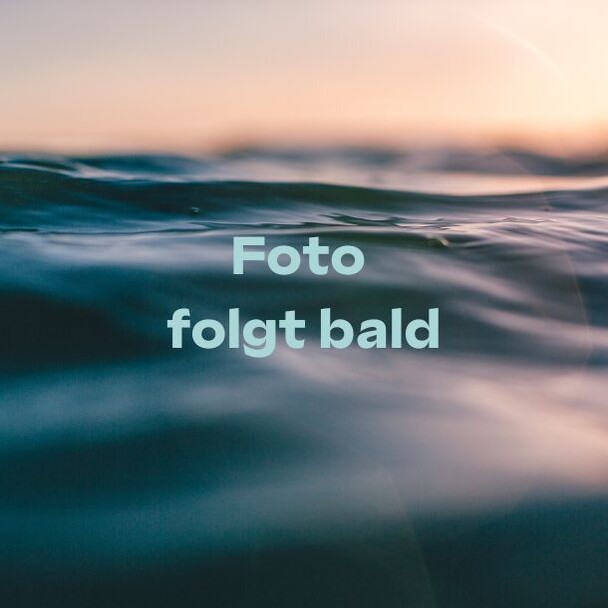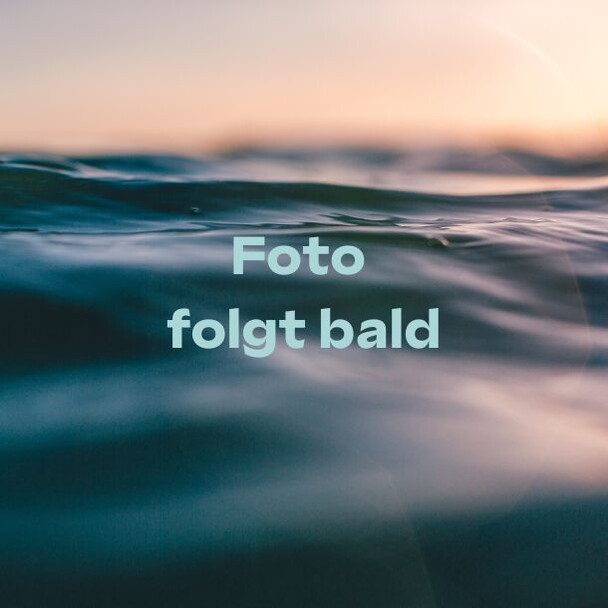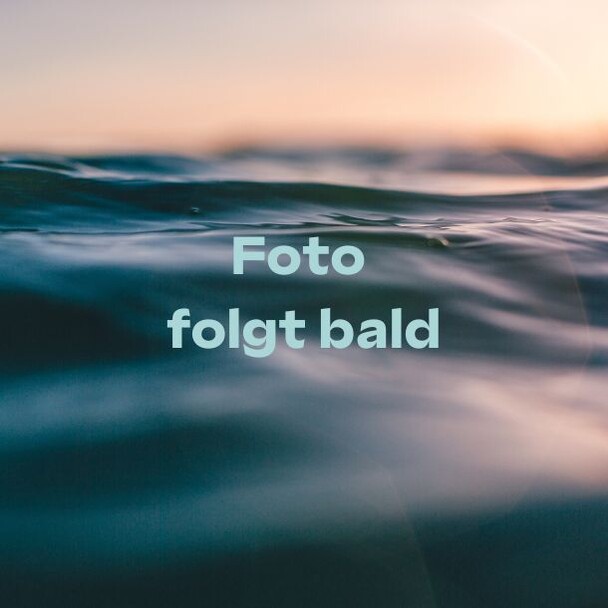Buying a surfboard - The ultimate guide
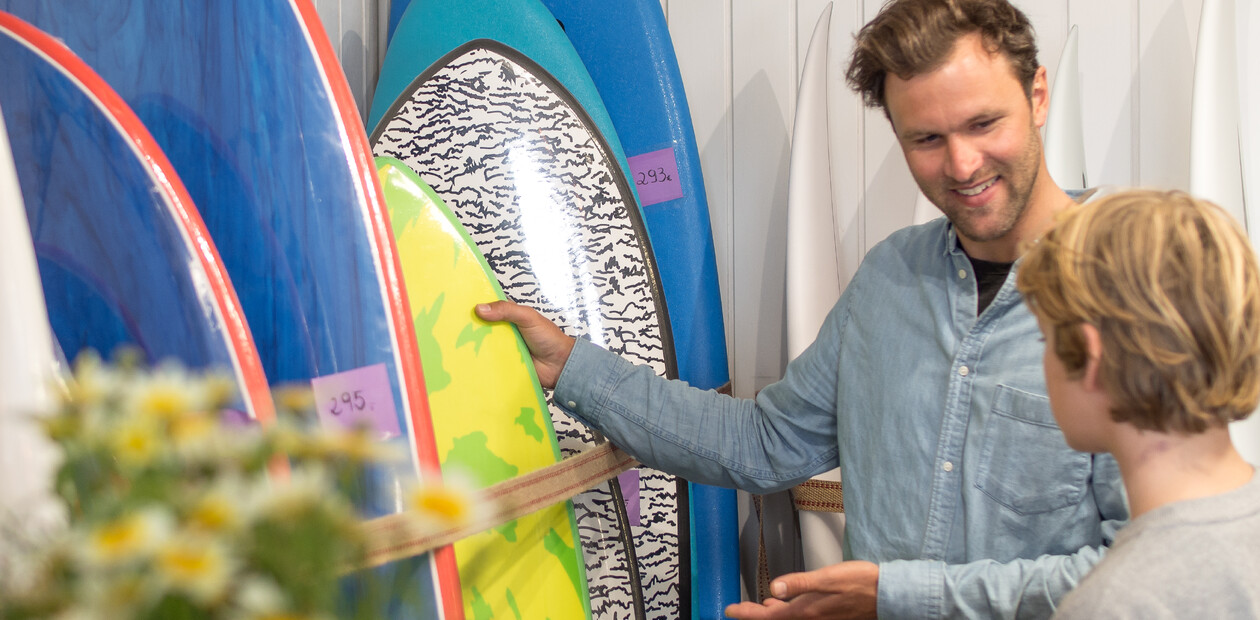
- Introduction - Buying a surfboard
- Types of surfboards
- Shortboard
- Longboard
- Fishboard
- Funboard
- Hybrid
- Found your surfboard? Book your vacation!
- Surfboard materials and construction methods
- Epoxy vs. polyurethane
- Softboards
- Important factors when buying a surfboard
- Experience level
- Weight and size
- Local conditions
- Additional features to consider when buying a surfboard
- Fin setup
- Rocker
- Rails
- Bought a surfboard? Book your vacation!
- Budget and value for money when buying a surfboard
- Price ranges and what you can expect in the respective categories
- Used vs. new surfboards
- What to look out for when buying a used surfboard
- Tips for buying a surfboard
- Where to buy surfboards
- Online stores vs. local surf stores
- Advice and testing options
- Surfboard shaping
- Which surfboard to buy - Conclusion
- Most important points

Jana is responsible for the website and blog at A-Frame. As a digital nomad and surf lover, she can work from anywhere in the world. She has currently opted for the Allgäu and El Palmar. For the Allgäu because of the love and for El Palmar because of the waves.
Introduction - Buying a surfboard
The right surfboard can make the difference between a frustrating and an unforgettable day in the water. A well-chosen surfboard not only improves your performance, but also makes surfing more fun by helping you catch waves more easily and ride more stable. Depending on your experience level, weight, size and the typical wave conditions at your surf spot, the requirements for the ideal surfboard will vary.
This article is intended to serve as a comprehensive guide to finding the perfect surfboard for your needs. We'll discuss the different types of surfboards, materials and construction methods, important buying criteria and tips for buying and maintaining your new surfboard. Whether you're a beginner or an advanced surfer, after reading this article you'll be well prepared to make an informed purchase decision and enjoy your time on the water to the fullest.
And if you've bought a surfboard, we look forward to welcoming you to our A-Frame surf camp. :)
Types of surfboards
When buying a surfboard, many people choose a board based on how it looks. A cool shape, not too big and the colors should also be right. Most surfers, especially beginners or intermediate surfers, tend to buy a surfboard that is too small. Too small means that it doesn't match the surfing level or fitness level. The surfboard may look cool, but it's not much fun in the water.
So many people are faced with the big question: Which surfboard shape is right for me? After all, there are many different shapes such as longboard, mini Malibu, shortboard, fish and many intermediate variants. The tails have different shapes and each surfboard has a different volume. In our blog article "The surfboard - The ultimate guide including types, materials, care and more" we explain in more detail the components of a surfboard and what advantages and disadvantages they have. But here is a brief overview:
Shortboard
Features:
Length: 5'6" to 7'0"
Pointed nose and sharp rails
Mostly equipped with three or four fins
Advantages:
Very agile and responsive
Ideal for fast, steep waves
Allows complex maneuvers and tricks
Disadvantages:
More difficult to paddle and catch waves
Less stable, especially for beginners
Suitable for which waves and surfers:
Suitable for advanced to experienced surfers
Ideal for powerful, fast waves
Longboard
Features:
Length: 8'0" to 12'0"
Rounded nose and soft rails
Often only one fin (single fin) or three fins (2+1 setup)
Advantages:
Very stable and easy to paddle
Ideal for smaller, softer waves
Allows relaxed cruising and nose riding
Disadvantages:
Less manoeuvrable and harder to manoeuvre
Not suitable for fast, steep waves
Which waves and surfers are suitable for:
Suitable for beginners and experienced surfers who want to surf in a relaxed manner
Ideal for small to medium, gentle waves
Fishboard
Features:
Length: 5'2" to 6'4"
Wide and thick shape with a split tail fin (Swallow Tail)
Mostly equipped with two or four fins
Advantages:
Fast acceleration and good stability
Ideal for smaller, less powerful waves
Combination of maneuverability and stability
Disadvantages:
Less suitable for very large or steep waves
Can be a little more difficult to control for beginners
What waves and surfers suitable for:
Suitable for advanced surfers and those who surf small to medium waves
Perfect for gentle, powerless wave conditions
Funboard
Features:
Length: 6'6" to 8'0"
Combination of longboard and shortboard features
Rounded nose and medium thickness
Advantages:
Good stability and easy paddling
Versatile and suitable for various conditions
Ideal for beginners and advanced paddlers
Disadvantages:
Not as maneuverable as a shortboard
Less stable than a longboard
Suitable for which waves and surfers:
Suitable for beginners to advanced surfers
Ideal for a variety of wave conditions, from small to medium
Hybrid
Features:
Length: Varies, often between 5'8" and 7'2"
Combination of different board shapes, often wider and thicker
Different fin configurations
Advantages:
Versatile and adaptable to different conditions
Good mix of stability and maneuverability
Ideal for surfers looking for an all-round board
Disadvantages:
Can be less performant in extreme conditions (very big or very small waves)
May not be as specialized as other board types
What waves and surfers are it suitable for:
Suitable for all experience levels, depending on the specific hybrid shape
Ideal for surfers who surf in a variety of conditions and are looking for a flexible board

Found your surfboard? Book your vacation!
Have you found your perfect surfboard? Then it's time to plan your next surfing adventure! Book your stay at A-Frame Surfcamp El Palmar and experience unforgettable days by the sea. Our offer includes:
* Accommodation:
Comfortable and cozy accommodation right on the beach.
* Catering:
Delicious and healthy meals to fuel you for the waves.
* Surf course:
Professional surf courses for all levels of experience.
Your surfing adventure starts here!
Surfboard materials and construction methods
Epoxy vs. polyurethane
Differences in material and production:
Epoxy:
Use of EPS (Expanded Polystyrene) foam core
Coated with epoxy resin
Manufacturing process often lighter and more environmentally friendly
Polyurethane (PU):
Use of PU foam core
Coated with polyester resin
More traditional manufacturing method, often used by handmade boards
Advantages and disadvantages:
Epoxy:
Advantages:
Lighter than PU boards
Stronger and more resistant to dents and breakages
Better buoyancy
Disadvantages:
Stiffer, which some surfers find less "sensitive"
More expensive to manufacture
Polyurethane:
Advantages:
Softer and more flexible feel on the wave
Traditional surfing experience, preferred by many pros
Often cheaper to buy
Disadvantages:
Heavier and less resistant to dents and breakages
Can absorb water and increase in weight over time
Effects on performance and durability:
Epoxy:
Better buoyancy and lightness increase paddling speed and make it easier to catch waves.
Higher durability leads to a longer lifespan, especially with frequent use.
Polyurethane:
The softer and more flexible material provides a better feel for the wave, which can be beneficial for finer maneuvers.
The lower durability can lead to damage more quickly with intensive use.
Softboards
Properties and advantages:
Properties:
Core made of soft foam, often covered with a soft top layer
Low hardness, which minimizes injuries while surfing
Mostly equipped with flexible, rounded fins
Advantages:
Very safe, especially for beginners and children
Inexpensive and easily accessible
Robust against bumps and dents
Easy to paddle and stable in the water
Target group and areas of use:
Target group:
Beginners and children who need safety and stability
Casual surfers who are looking for an easy-care board
Surf schools and rental stations that need robust and user-friendly boards
Application areas:
Ideal for small to medium, gentle waves
Perfect for learning environments and safe surfing conditions
Well suited for crowded beaches where the risk of collisions is high
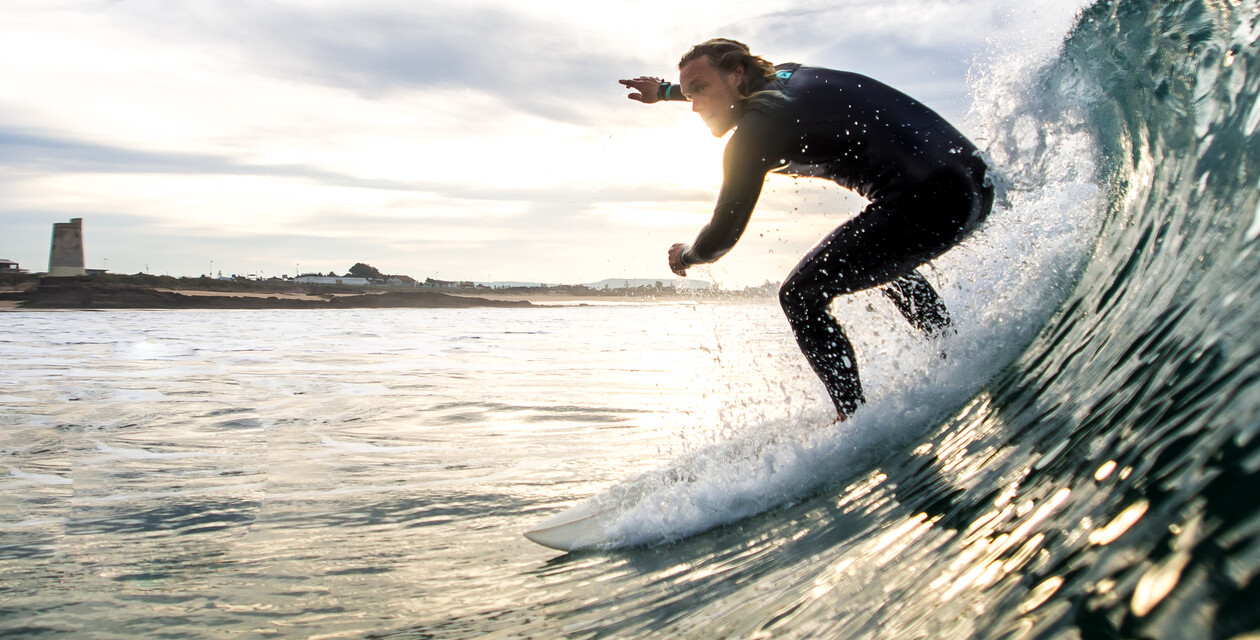
Important factors when buying a surfboard
Choosing the right surfboard depends heavily on your experience level, weight and height as well as the local surfing conditions. By taking these factors into account, you can ensure that you find the right board for your needs and maximize your surfing experience. :)
Experience level
Beginner:
Recommended boards: Longboards, funboards, softboards
Properties: Stability, easy paddling, good flotation
Why: Beginners need boards that are easy to handle to keep their balance and catch waves more easily.
Advanced:
Recommended boards: Fishboards, hybrids, shorter funboards
Properties: Combination of stability and maneuverability, versatile for different wave conditions
Why: Advanced surfers need boards that are more versatile and allow them to refine their technique and ride different waves.
Pro:
Recommended boards: Shortboards, specialized hybrids
Properties: High maneuverability, responsive, adapted to specific surfing conditions
Why: Professionals need boards that are extremely responsive and allow them to perform complex maneuvers and tricks.
Weight and size
Influence on the choice of board:
Weight: Heavier surfers need larger and thicker boards to ensure sufficient buoyancy and stability. Lighter surfers can use smaller, thinner boards that are more maneuverable.
Size: Larger surfers benefit from longer boards that offer more stability and are easier to paddle. Smaller surfers can choose shorter boards that are easier to handle.
General guidelines:
Light surfers: Smaller boards (under 6'0") with less volume
Medium-weight surfers: Medium boards (6'0" to 8'0") with medium volume
Heavy surfers: Larger boards (over 8'0") with more volume
Local conditions
Typical wave heights and types at your surf spot:
Small waves (under 3 feet):
Recommended boards: Longboards, funboards, fishboards
Properties: More volume for better flotation and stability
Medium sized waves (3 to 6 feet):
Recommended boards: Hybrids, shortboards, funboards
Properties: Blend of volume and maneuverability to provide both stability and maneuverability
Large waves (over 6 feet):
Recommended boards: Shortboards, specialized big wave boards
Features: Lower volume for better control and speed, rugged construction for durability in demanding conditions
Additional considerations:
Beach or reef breaks:
Beach breaks: Longboards and funboards are well suited as they make the most of gentle and slow breaking waves.
Reef breaks: Shortboards and hybrids are better as they are suitable for fast, hollow waves.
Wind and weather conditions:
In strong winds: Heavier and more stable boards are advantageous for gliding better through the water.
In calm conditions: Lighter and more maneuverable boards can be used optimally.

Additional features to consider when buying a surfboard
Fin setup
The fin setup of a surfboard significantly influences its performance in the water. There are different configurations, each with their own advantages and disadvantages:
Single fin:
This setup consists of a single fin in the center of the board. It offers a stable ride, good control and smooth turns, but is less maneuverable and faster than other setups. Single fin boards are ideal for longboards and retro boards, especially suitable for small to medium waves.
Twin Fin:
Two fins are arranged symmetrically. This setup enables high speed and maneuverability as well as easy turns. However, it offers less stability in big waves. Twin Fin boards are perfect for fishboards and small to medium waves.Thruster (Three-Fin):
The Thruster setup includes three fins - one center and two side fins. It offers a balanced combination of stability and maneuverability as well as good control. However, this setup can be slower than twin fin or quad setups. Thruster boards are the most common on modern shortboards and offer all-round performance in various conditions.Quad Fin:
With four symmetrically arranged fins, this setup offers high speed and stability as well as good control in steep waves. However, it allows for less loose turns than twin fin setups. Quad Fin boards are ideal for performance boards and big, steep waves.Five-Fin Setup:
This setup offers the possibility to switch between different configurations (single, twin, thruster, quad). It offers versatility and adaptation to different conditions, but can be complex and affect performance depending on the setup. Five-fin boards are ideal for surfers looking for flexibility and adaptability.
The choice of fin setup significantly affects the stability, speed, maneuverability and control of the surfboard. Single fin and thruster setups offer more stability, while twin and quad setups provide more speed and loose turns. Thruster and quad setups also offer better control in steep and big waves.
Rocker
The rocker refers to the curvature of the surfboard from the tip (nose) to the end (tail). A flat rocker offers more speed and makes paddling easier, which makes it ideal for small to medium waves. However, a flat rocker can offer less control in steep waves. A strong rocker, on the other hand, offers better maneuverability and control in steep and large waves, but reduces speed and makes paddling more difficult.
Rails
The rails (edges) of a surfboard also influence the riding behavior:
Full rails (thick rails):
These round, thicker rails offer more buoyancy and stability and are more forgiving in the event of mistakes. They are ideal for beginners, longboards and softer waves, but offer less maneuverability and control in critical situations.Tapered Rails:
Thinner and sharper towards the edges, these rails offer better maneuverability and control, especially in steep waves. They offer less buoyancy and stability and are better suited for advanced and professional surfers as well as shortboards.Hard Rails:
With sharp edges, especially at the tail, these rails enable fast, precise turns and better grip in the wave. They are less forgiving and require more skill, ideal for performance boards and experienced surfers.Soft Rails:
These rounded edges offer a smoother ride and more stability, are good for slow turns, but are less precise and responsive. They are ideal for beginners, longboards and softer waves.
Considering these additional features will help you choose a surfboard that is perfectly suited to your needs and the conditions at your surf spot.

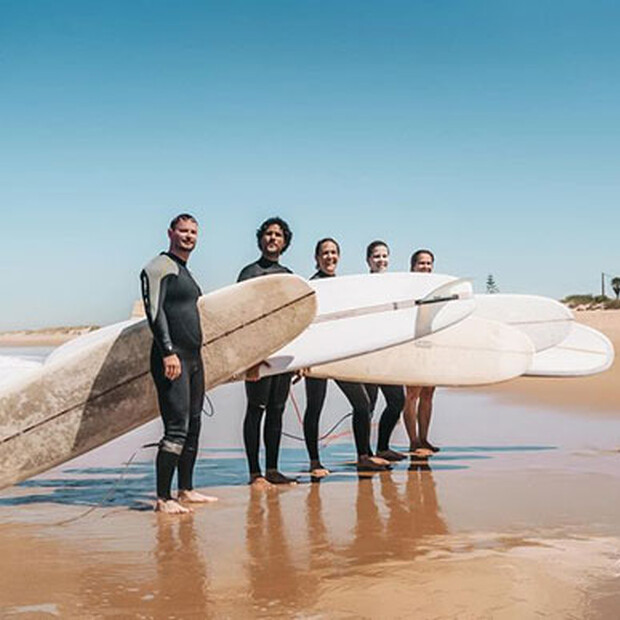
Bought a surfboard? Book your vacation!
Have you found your perfect surfboard? Then it's time to plan your next surfing adventure! Book your stay at A-Frame Surfcamp El Palmar and experience unforgettable days by the sea. Our offer includes:
* Accommodation:
Comfortable and cozy accommodation right on the beach.
* Catering:
Delicious and healthy meals to fuel you for the waves.
* Surf course:
Professional surf courses for all levels of experience.
Your surfing adventure starts here!
Budget and value for money when buying a surfboard
When buying a surfboard, the price varies depending on the material, construction and brand. Here is an overview of the typical price ranges and what you can expect in each category:
Price ranges and what you can expect in the respective categories
Beginner boards (€150 - €400):
Material: Often softboards or cheaper epoxy boards
Properties: Stable, robust and safe, ideal for beginners
Expectations: Good durability and easy handling, but possibly less performance-oriented
Mid-range boards (€400 - €800):
Material: Higher quality epoxy and PU boards
Properties: Better performance, combination of stability and maneuverability
Expectations: Good balance between price and performance, suitable for advanced surfers
Premium boards (€800 and more):
Material: Highest quality materials, often custom-made PU and epoxy boards
Properties: Maximum performance, lightweight and robust construction
Expectations: Top quality and performance, often used by professional surfers
Used vs. new surfboards
When buying a surfboard, you are faced with the decision of whether to buy a new or a used board. Both options have their advantages and disadvantages:
New surfboards:
Advantages:
Latest technology and materials
No wear and tear or repairs necessary
Warranty and support from the manufacturer
Disadvantages:
Higher price
Loss of value after first use
Used surfboards:
Advantages:
Favorable price
Opportunity to purchase high-quality boards at a fraction of the price of new
Sustainable
Disadvantages:
Possible wear and tear and repairs necessary
No warranty
What to look out for when buying a used surfboard
When buying a used surfboard, there are some important points to consider to ensure that you get good value for money:
Condition of the board:
Dents and cracks: Look out for larger dents or cracks in the deck, especially on the rails and tail. Small dents are normal, but larger damage can affect performance and durability.
Water damage: Check the board for water damage. This can be indicated by yellowish discoloration or soft spots on the board.
Fins and fin boxes:
Condition: Check whether the fins and fin boxes are in good condition. Damaged or loose fin boxes can be expensive to repair.
Deck and underside:
Glaze: Look for cracks or flaking in the glaze. These can lead to water absorption and further damage.
Delamination: Check whether the fiberglass fabric is detaching from the foam core, which is a sign of severe damage.
Make and model:
Research: Find out the make and model of the board to make sure it is suitable for your needs and is reasonably priced.
Price comparison:
Market value: Compare the prices of similar used boards to make sure you're getting a fair deal.
Buying a used surfboard can be a great way to save money and still get a high-quality board. With careful inspection and a little research, you'll find the perfect board that meets your needs and will last you a long time.
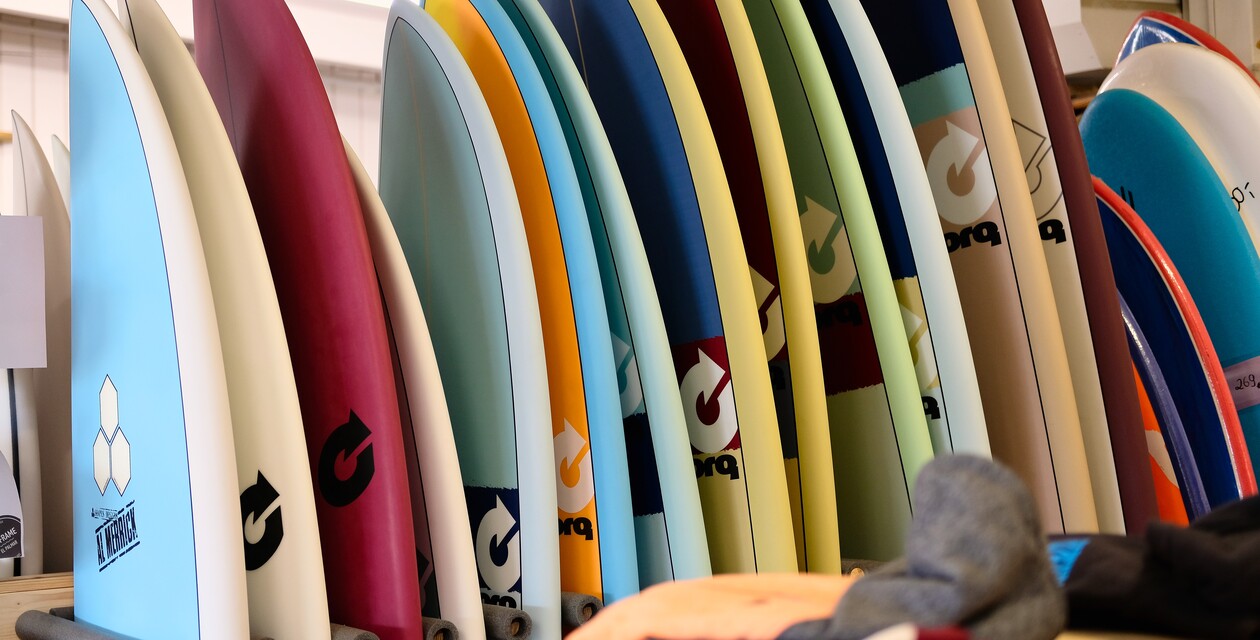
Tips for buying a surfboard
Where to buy surfboards
There are several options when buying a surfboard, each with their own advantages:
Online stores: A wide selection of brands and models, often with detailed product descriptions and customer reviews. Good prices and regular offers are another advantage. However, shipping costs can be high and you can't inspect the board in person before buying.
Local surf stores: Personal advice and the opportunity to see and touch the board before buying. Local stores support the local economy and often offer repair services. However, the selection can be more limited and prices higher than online.
Online stores vs. local surf stores
Online stores:
Advantages: Large selection, often lower prices, convenient shopping from home.
Disadvantages: No opportunity to test the board before buying, shipping costs, possible problems with returns.
Local surf stores:
Advantages: Personal advice, opportunity to inspect the board, support for the local economy, often also repair services.
Disadvantages: Possibly higher prices, more limited selection.
Advice and testing options
Use of test centers and consultations:
Test centers: Many surf stores, especially in surf-intensive regions, offer test centers where you can try out different board types and models before making a purchase decision. This is particularly helpful for comparing the feel of different boards and finding the model that suits you best.
Consultation sessions: In local surf stores, you can benefit from the experience and knowledge of the staff. They can help you find the right board based on your experience level, weight and preferred surfing conditions. Online stores also often offer customer service and advice by phone, email or chat.
Tips for taking advantage of advice and testing opportunities:
Open questions: Be prepared to share detailed information about your surf level, your preferences and the conditions at your surf spot.
Patience when testing: Take the time to try out different boards. A few test rides can help you get the right feel for the board.
Use advice: Don't hesitate to use the expertise of the sales staff. They can often provide valuable advice and help you make a decision.
Buying a surfboard is an investment that will have a significant impact on your surfing experience. With the right advice and testing options, you can ensure that you find the perfect board for your needs and enjoy it for a long time to come.
Surfboard shaping
Having a custom surfboard shaped is a great way to get a board that is perfectly tailored to your individual needs and surfing style. With a custom surfboard, you can customize every aspect, from the shape to the dimensions to the design. This not only gives you the opportunity to improve your performance in the water, but also to own a unique board that is exactly what you want.
The price of a custom surfboard depends on various factors, including the choice of material, the complexity of the design and the experience of the shaper. In general, the cost of a custom surfboard is between 550 and 1,100 euros. Key cost factors include the materials used, such as the foam core and fiberglass, the shaper's labor costs and additional features such as special color schemes or additional layers of glazing.
Working with an experienced shaper allows you to develop a board that is not only functional, but also meets your aesthetic needs. A custom surfboard can take your surfing skills to the next level, giving you a personalized, handcrafted product that performs in every wave.

Which surfboard to buy - Conclusion
Buying a surfboard is an important decision that can have a significant impact on your surfing experience. Here are the most important points you should consider:
Most important points
Types of surfboards: There are different types of surfboards such as shortboards, longboards, fishboards, funboards and hybrids, each with different characteristics and areas of use. Choose the board that best suits your experience level and wave conditions.
Materials and construction: The choice between epoxy and polyurethane boards has an impact on performance and durability. Epoxy boards are lighter and more robust, while PU boards offer a more traditional feel. Softboards are ideal for beginners and children.
Important factors to consider when buying: Take into account your experience level, weight and height as well as local surfing conditions to find the right board.
Additional features: Pay attention to the fin setup, rocker and rails of your board, as these affect stability, maneuverability and control.
Budget and value for money: Surfboards come in different price ranges. Used boards can be a cost-effective alternative if they are in good condition.
Tips for buying: Surfboards can be purchased both online and in local surf stores. Test centers and consultations are valuable resources for finding the ideal board.
Encouragement: Take the time to choose the right surfboard to suit your individual needs. With the right board, you can maximize your surfing experience and enjoy surfing to the fullest. Whether you're a beginner or an experienced surfer, the right surfboard will help you get the most out of every wave and develop your skills. Have fun and successful sessions in the water!

